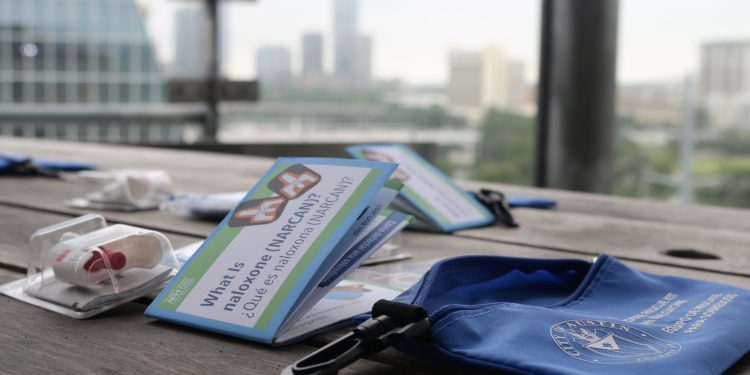AUSTIN, Texas — Local officials announced significant progress Monday in combating the opioid epidemic that has ravaged Texas communities, highlighting the success of a $2 million federally funded initiative that has distributed over 24,000 life-saving naloxone doses and trained more than 1,100 residents to respond to overdoses.
Mayor Kirk Watson and Travis County Judge Andy Brown joined Austin Public Health, Austin-Travis County EMS, and community partners at City Hall to unveil results from the one-time federal grant, secured through Congressman Lloyd Doggett and administered by the Substance Abuse and Mental Health Services Administration (SAMHSA).
The announcement comes as Texas grapples with a devastating drug overdose epidemic that has claimed thousands of lives over the past decade. State health data shows Texas drug poisoning deaths increased more than 75% in the past five years, with the death rate nearly doubling from 9.4 deaths per 100,000 residents in 2017 to 15.8 deaths per 100,000 residents in 2021. Since 2019, accidental drug deaths have tripled in Travis County specifically.
“Last year, we promised to put this funding to work in a way that saves lives,” Watson said. “I’m proud to say we delivered. Thanks to strong partnerships and focused efforts, we’re no longer just reacting to a crisis—we’re building a system that prevents it.”
Texas Faces Mounting Crisis
The Lone Star State has not been immune to the national opioid epidemic that has claimed hundreds of thousands of lives nationwide. While specific year-by-year data for Texas remains limited in public reporting, health officials paint a grim picture of the crisis’s trajectory.
Current statistics show approximately 3,136 overdose deaths per year in Texas, representing 1.55% of all deaths in the state. The crisis has been fueled largely by synthetic opioids, particularly fentanyl, which has dramatically increased the lethality of the illicit drug supply.
Nationally, the opioid crisis peaked in 2022 with over 111,000 deaths before showing the first signs of improvement. Provisional data indicates there were an estimated 107,543 drug overdose deaths in the United States during 2023—a decrease of 3% from 2022, marking the first annual decrease since 2018.
Local Success Story
Against this backdrop of statewide and national crisis, Austin and Travis County’s initiative stands as a beacon of hope. The program’s multi-pronged approach has yielded measurable results:
Naloxone Distribution and Training: Over 24,000 doses of the opioid reversal drug naloxone have been distributed throughout the community, while more than 1,100 people have completed “Breathe Now” overdose response training.
Community Partnerships: The Texas Harm Reduction Alliance hired peer coaching staff who worked with more than 100 clients, providing 431 linkages to healthcare, social services, and treatment programs. Staff also conducted hundreds of assessments for individuals transitioning from incarceration to homelessness.
Communities for Recovery provided peer support to more than 50 people, with 80% showing measurable progress toward their recovery goals. The organization led over 200 groups and activities reaching more than 2,000 attendees.
Healthcare Professional Education: The University of Texas Pharmacy Addition Research Medicine Program developed specialized training courses for healthcare providers treating opioid use disorder. Nearly 600 providers received training, with most reporting increased comfort in providing care and intentions to incorporate more harm reduction principles.
Public Awareness Campaign: UT’s Center for Health Communication created the “In Austin, We Keep Each Other Safe” media campaign, which delivered 56 million impressions across various media platforms and drew over 58,000 visitors to its website.
Signs of Progress
Most significantly, officials report that overdose deaths in Austin are now declining—a key indicator of the program’s effectiveness in a region that had seen deaths triple since 2019.
“This decrease is just the beginning,” said Travis County Judge Andy Brown. “Together we’re building a stronger foundation rooted in compassion, data and a commitment to ensuring every member of our community has access to the resources they need to survive and thrive.”
Austin-Travis County Health Authority Dr. Desmar Walkes emphasized the collaborative nature of the success. “This once-in-a-lifetime funding opportunity has saved lives and made an impact in our fight against this epidemic. While there is still much to be done, the groundwork that was laid in the past year has made our community more resilient and united in the mission to prevent overdose deaths.”
Ongoing Challenges
Despite the local success, Congressman Doggett warned of potential setbacks at the national level. “At present, however, the biggest threat to substance abuse treatment are the outrageous Medicaid cuts being advanced in Congress,” Doggett said, referencing what he called the “One Big, Beautiful Bill” that could result in “16 million Americans” losing access to healthcare services.
ATCEMS Chief Robert Luckritz highlighted how first responders are adapting their approach to the crisis. “Our paramedics see the impact of opioids every day, and we’ve made it our mission to turn those moments of crisis into opportunities for connection and care,” he said. “Through our Community Health Paramedics and Opiate Use Disorder Support Program, we’re not just responding to overdoses, we’re building relationships, offering resources, and helping people take the first steps toward recovery.”
Prevention and Response
Health officials continue to emphasize the importance of community awareness and preparation. Key recommendations for preventing and responding to opioid overdoses include:
- Never using drugs alone or behind locked doors
- Ensuring others know if naloxone is available
- Recognizing overdose signs: small pupils, decreased responsiveness, and slow or absent breathing
- Administering naloxone immediately if overdose is suspected, even if uncertain
- Calling 911, as fatal opioids typically outlast intranasal naloxone’s 90-minute effectiveness
The initiative’s success in Austin and Travis County offers a model for other Texas communities grappling with the opioid crisis. As the state continues to face rising overdose deaths, local officials hope their collaborative approach can be replicated elsewhere.
For more information about recognizing and preventing opioid overdoses, residents can visit stopoverdoseatx.org.




